International Project Management: Monitoring and Controlling
VerifiedAdded on 2020/05/08
|6
|1416
|169
Report
AI Summary
This report focuses on international project management, specifically addressing the crucial aspects of monitoring and controlling project progress. The report emphasizes the significance of a project governance plan, highlighting how to effectively track a project's development. It underscores the importance of regular monitoring, encompassing schedule, cost, and risk assessment, alongside corrective actions. The report recommends face-to-face meetings with the CEO as the most appropriate method for communication and progress updates, detailing the information/data that should be provided. It explores methodologies, advantages, and risks associated with project monitoring, recommending face-to-face meetings as the best method. The report also outlines the structure for CEO and Board project reports, including meeting agendas, minutes, and feedback integration.
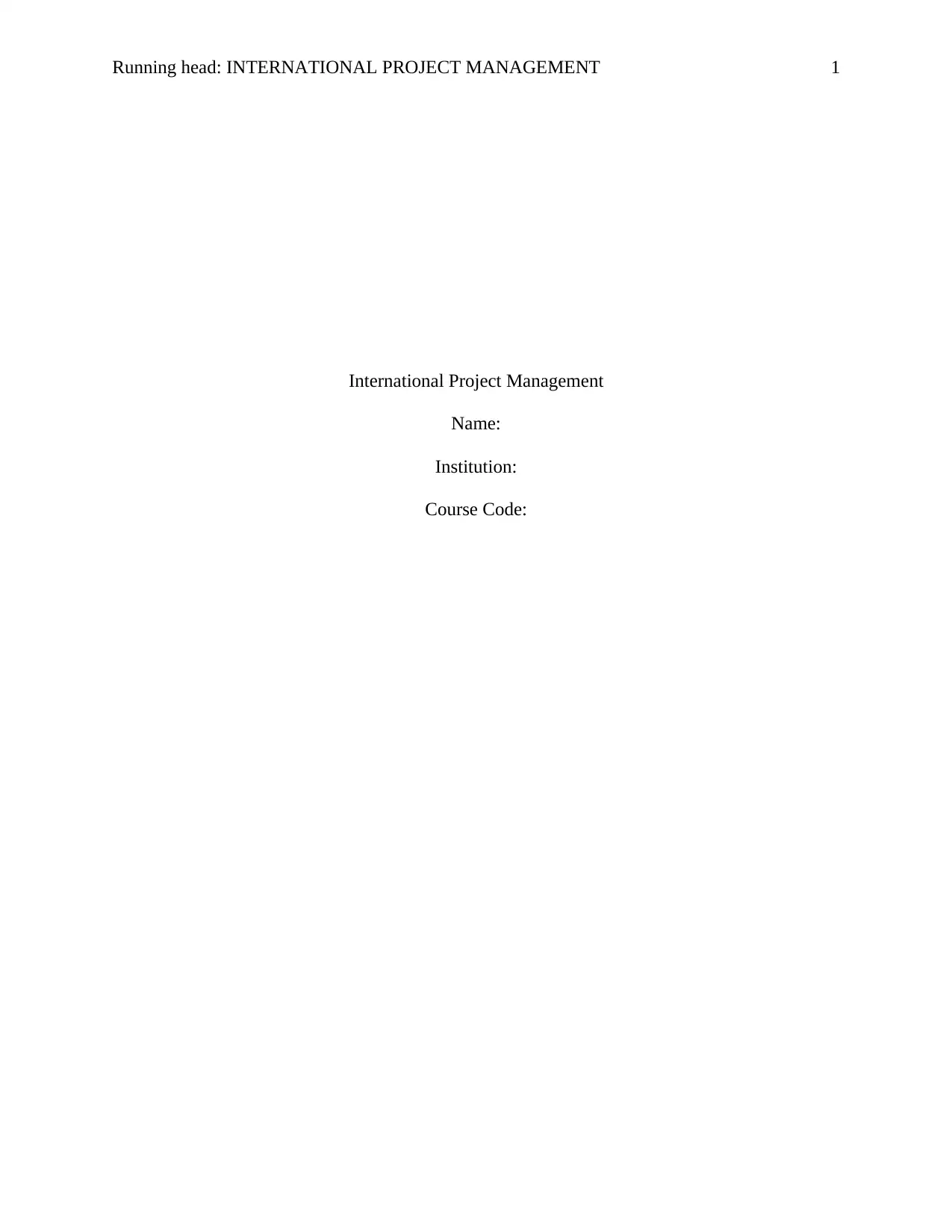
Running head: INTERNATIONAL PROJECT MANAGEMENT 1
International Project Management
Name:
Institution:
Course Code:
International Project Management
Name:
Institution:
Course Code:
Paraphrase This Document
Need a fresh take? Get an instant paraphrase of this document with our AI Paraphraser
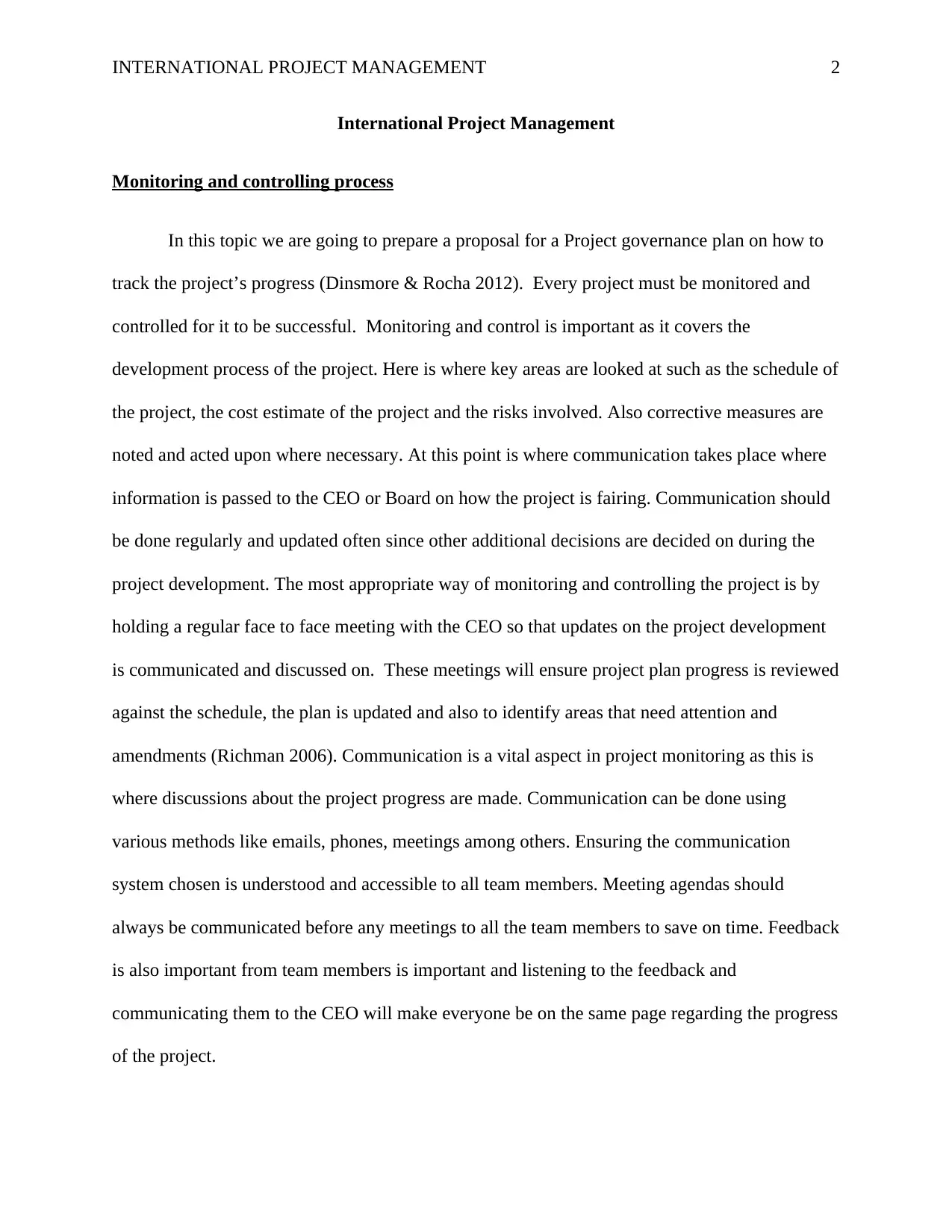
INTERNATIONAL PROJECT MANAGEMENT 2
International Project Management
Monitoring and controlling process
In this topic we are going to prepare a proposal for a Project governance plan on how to
track the project’s progress (Dinsmore & Rocha 2012). Every project must be monitored and
controlled for it to be successful. Monitoring and control is important as it covers the
development process of the project. Here is where key areas are looked at such as the schedule of
the project, the cost estimate of the project and the risks involved. Also corrective measures are
noted and acted upon where necessary. At this point is where communication takes place where
information is passed to the CEO or Board on how the project is fairing. Communication should
be done regularly and updated often since other additional decisions are decided on during the
project development. The most appropriate way of monitoring and controlling the project is by
holding a regular face to face meeting with the CEO so that updates on the project development
is communicated and discussed on. These meetings will ensure project plan progress is reviewed
against the schedule, the plan is updated and also to identify areas that need attention and
amendments (Richman 2006). Communication is a vital aspect in project monitoring as this is
where discussions about the project progress are made. Communication can be done using
various methods like emails, phones, meetings among others. Ensuring the communication
system chosen is understood and accessible to all team members. Meeting agendas should
always be communicated before any meetings to all the team members to save on time. Feedback
is also important from team members is important and listening to the feedback and
communicating them to the CEO will make everyone be on the same page regarding the progress
of the project.
International Project Management
Monitoring and controlling process
In this topic we are going to prepare a proposal for a Project governance plan on how to
track the project’s progress (Dinsmore & Rocha 2012). Every project must be monitored and
controlled for it to be successful. Monitoring and control is important as it covers the
development process of the project. Here is where key areas are looked at such as the schedule of
the project, the cost estimate of the project and the risks involved. Also corrective measures are
noted and acted upon where necessary. At this point is where communication takes place where
information is passed to the CEO or Board on how the project is fairing. Communication should
be done regularly and updated often since other additional decisions are decided on during the
project development. The most appropriate way of monitoring and controlling the project is by
holding a regular face to face meeting with the CEO so that updates on the project development
is communicated and discussed on. These meetings will ensure project plan progress is reviewed
against the schedule, the plan is updated and also to identify areas that need attention and
amendments (Richman 2006). Communication is a vital aspect in project monitoring as this is
where discussions about the project progress are made. Communication can be done using
various methods like emails, phones, meetings among others. Ensuring the communication
system chosen is understood and accessible to all team members. Meeting agendas should
always be communicated before any meetings to all the team members to save on time. Feedback
is also important from team members is important and listening to the feedback and
communicating them to the CEO will make everyone be on the same page regarding the progress
of the project.
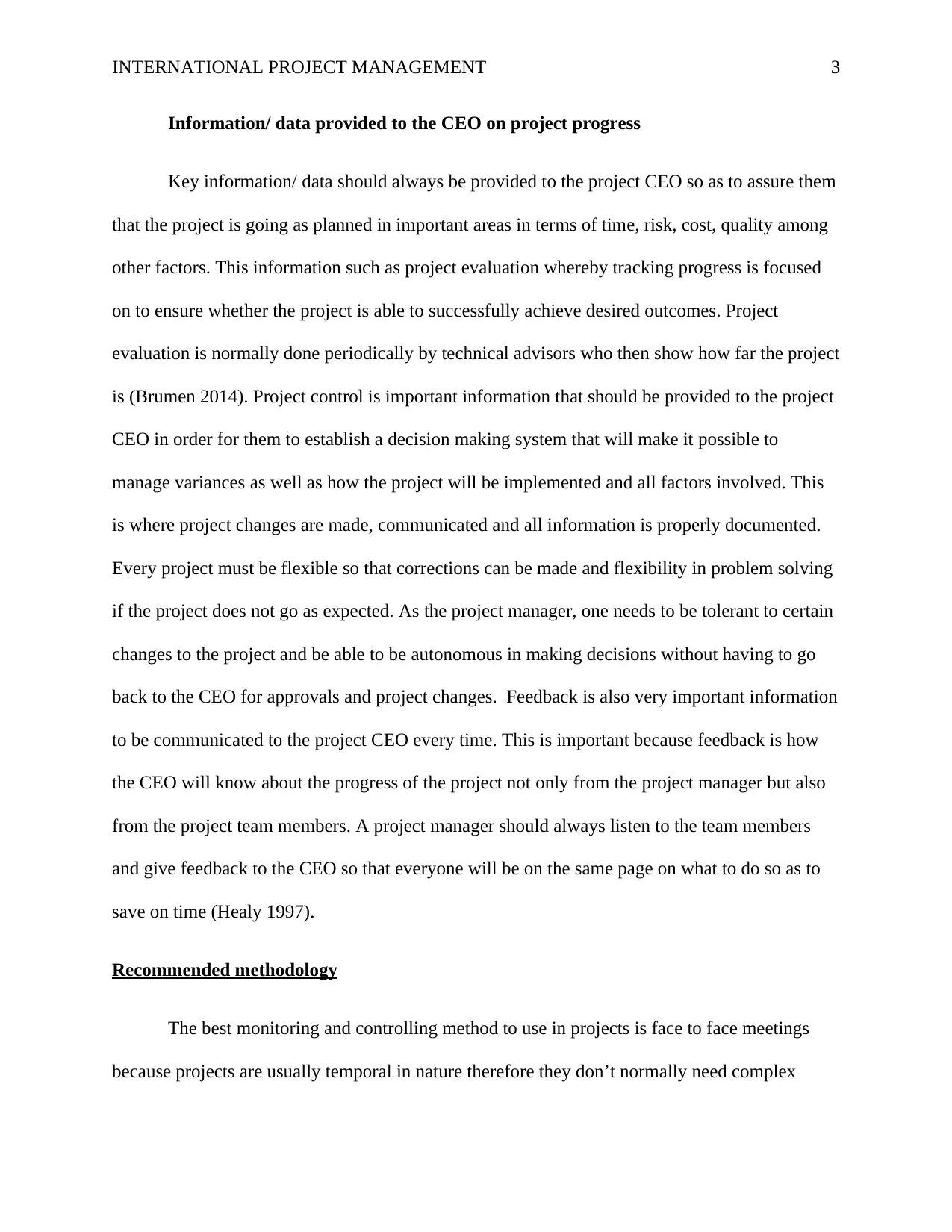
INTERNATIONAL PROJECT MANAGEMENT 3
Information/ data provided to the CEO on project progress
Key information/ data should always be provided to the project CEO so as to assure them
that the project is going as planned in important areas in terms of time, risk, cost, quality among
other factors. This information such as project evaluation whereby tracking progress is focused
on to ensure whether the project is able to successfully achieve desired outcomes. Project
evaluation is normally done periodically by technical advisors who then show how far the project
is (Brumen 2014). Project control is important information that should be provided to the project
CEO in order for them to establish a decision making system that will make it possible to
manage variances as well as how the project will be implemented and all factors involved. This
is where project changes are made, communicated and all information is properly documented.
Every project must be flexible so that corrections can be made and flexibility in problem solving
if the project does not go as expected. As the project manager, one needs to be tolerant to certain
changes to the project and be able to be autonomous in making decisions without having to go
back to the CEO for approvals and project changes. Feedback is also very important information
to be communicated to the project CEO every time. This is important because feedback is how
the CEO will know about the progress of the project not only from the project manager but also
from the project team members. A project manager should always listen to the team members
and give feedback to the CEO so that everyone will be on the same page on what to do so as to
save on time (Healy 1997).
Recommended methodology
The best monitoring and controlling method to use in projects is face to face meetings
because projects are usually temporal in nature therefore they don’t normally need complex
Information/ data provided to the CEO on project progress
Key information/ data should always be provided to the project CEO so as to assure them
that the project is going as planned in important areas in terms of time, risk, cost, quality among
other factors. This information such as project evaluation whereby tracking progress is focused
on to ensure whether the project is able to successfully achieve desired outcomes. Project
evaluation is normally done periodically by technical advisors who then show how far the project
is (Brumen 2014). Project control is important information that should be provided to the project
CEO in order for them to establish a decision making system that will make it possible to
manage variances as well as how the project will be implemented and all factors involved. This
is where project changes are made, communicated and all information is properly documented.
Every project must be flexible so that corrections can be made and flexibility in problem solving
if the project does not go as expected. As the project manager, one needs to be tolerant to certain
changes to the project and be able to be autonomous in making decisions without having to go
back to the CEO for approvals and project changes. Feedback is also very important information
to be communicated to the project CEO every time. This is important because feedback is how
the CEO will know about the progress of the project not only from the project manager but also
from the project team members. A project manager should always listen to the team members
and give feedback to the CEO so that everyone will be on the same page on what to do so as to
save on time (Healy 1997).
Recommended methodology
The best monitoring and controlling method to use in projects is face to face meetings
because projects are usually temporal in nature therefore they don’t normally need complex
⊘ This is a preview!⊘
Do you want full access?
Subscribe today to unlock all pages.

Trusted by 1+ million students worldwide
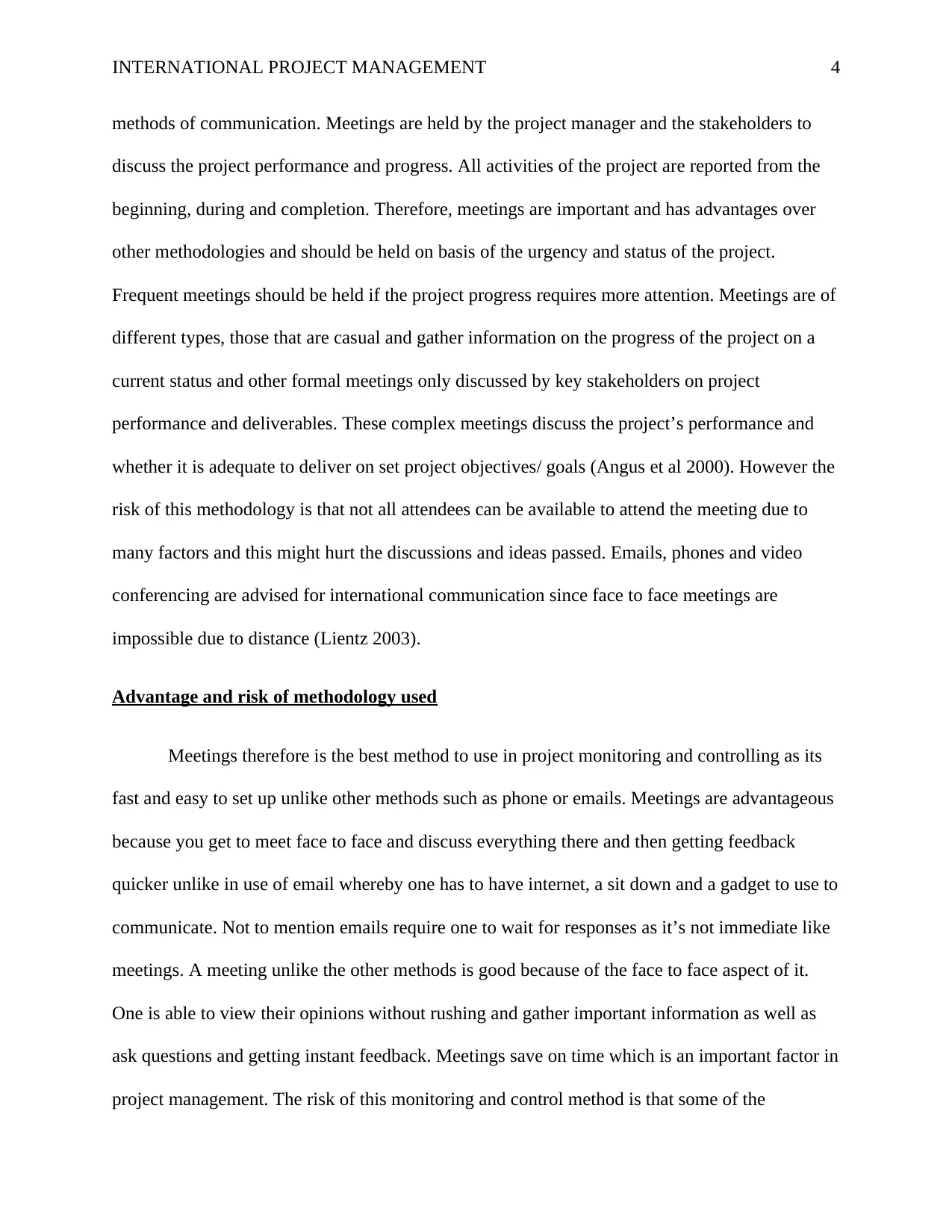
INTERNATIONAL PROJECT MANAGEMENT 4
methods of communication. Meetings are held by the project manager and the stakeholders to
discuss the project performance and progress. All activities of the project are reported from the
beginning, during and completion. Therefore, meetings are important and has advantages over
other methodologies and should be held on basis of the urgency and status of the project.
Frequent meetings should be held if the project progress requires more attention. Meetings are of
different types, those that are casual and gather information on the progress of the project on a
current status and other formal meetings only discussed by key stakeholders on project
performance and deliverables. These complex meetings discuss the project’s performance and
whether it is adequate to deliver on set project objectives/ goals (Angus et al 2000). However the
risk of this methodology is that not all attendees can be available to attend the meeting due to
many factors and this might hurt the discussions and ideas passed. Emails, phones and video
conferencing are advised for international communication since face to face meetings are
impossible due to distance (Lientz 2003).
Advantage and risk of methodology used
Meetings therefore is the best method to use in project monitoring and controlling as its
fast and easy to set up unlike other methods such as phone or emails. Meetings are advantageous
because you get to meet face to face and discuss everything there and then getting feedback
quicker unlike in use of email whereby one has to have internet, a sit down and a gadget to use to
communicate. Not to mention emails require one to wait for responses as it’s not immediate like
meetings. A meeting unlike the other methods is good because of the face to face aspect of it.
One is able to view their opinions without rushing and gather important information as well as
ask questions and getting instant feedback. Meetings save on time which is an important factor in
project management. The risk of this monitoring and control method is that some of the
methods of communication. Meetings are held by the project manager and the stakeholders to
discuss the project performance and progress. All activities of the project are reported from the
beginning, during and completion. Therefore, meetings are important and has advantages over
other methodologies and should be held on basis of the urgency and status of the project.
Frequent meetings should be held if the project progress requires more attention. Meetings are of
different types, those that are casual and gather information on the progress of the project on a
current status and other formal meetings only discussed by key stakeholders on project
performance and deliverables. These complex meetings discuss the project’s performance and
whether it is adequate to deliver on set project objectives/ goals (Angus et al 2000). However the
risk of this methodology is that not all attendees can be available to attend the meeting due to
many factors and this might hurt the discussions and ideas passed. Emails, phones and video
conferencing are advised for international communication since face to face meetings are
impossible due to distance (Lientz 2003).
Advantage and risk of methodology used
Meetings therefore is the best method to use in project monitoring and controlling as its
fast and easy to set up unlike other methods such as phone or emails. Meetings are advantageous
because you get to meet face to face and discuss everything there and then getting feedback
quicker unlike in use of email whereby one has to have internet, a sit down and a gadget to use to
communicate. Not to mention emails require one to wait for responses as it’s not immediate like
meetings. A meeting unlike the other methods is good because of the face to face aspect of it.
One is able to view their opinions without rushing and gather important information as well as
ask questions and getting instant feedback. Meetings save on time which is an important factor in
project management. The risk of this monitoring and control method is that some of the
Paraphrase This Document
Need a fresh take? Get an instant paraphrase of this document with our AI Paraphraser
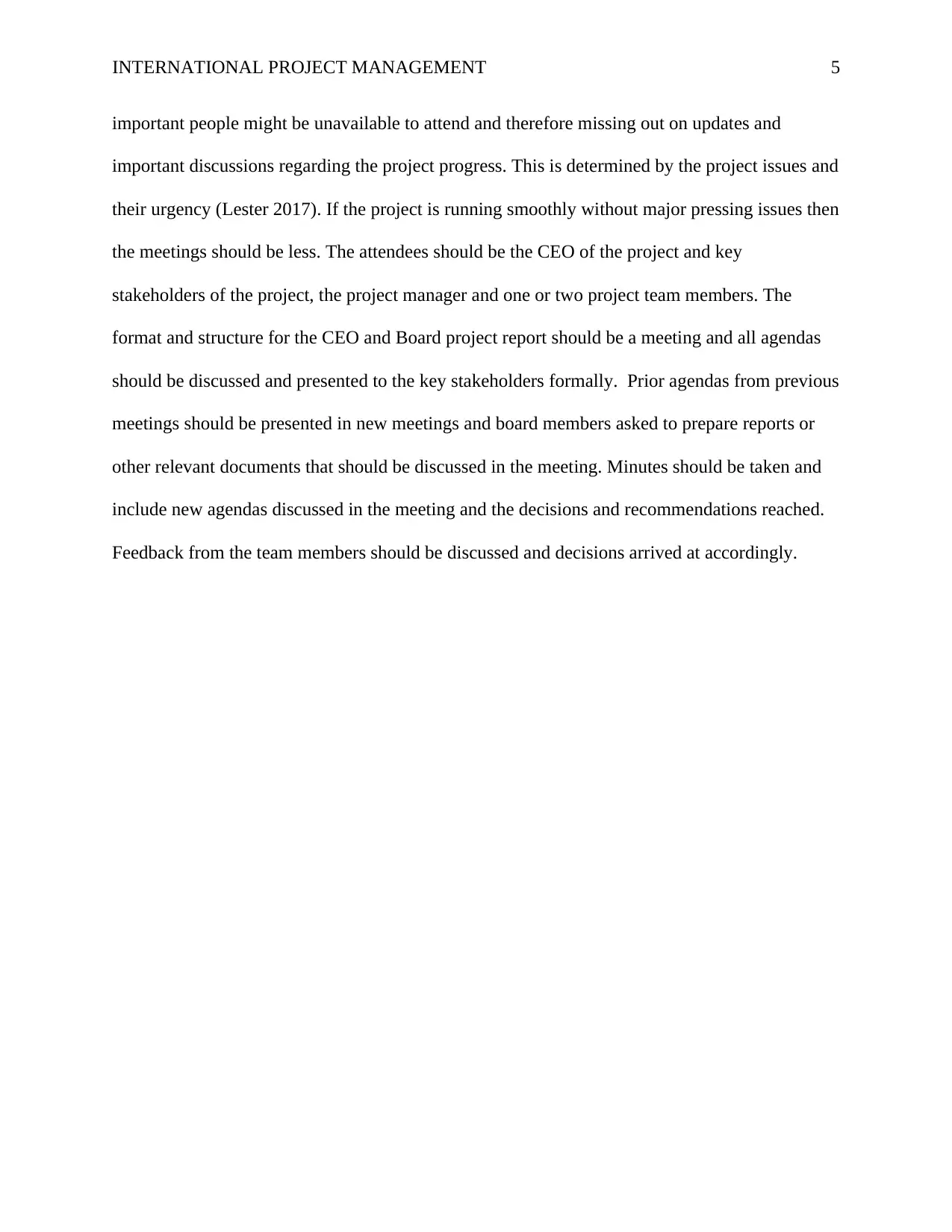
INTERNATIONAL PROJECT MANAGEMENT 5
important people might be unavailable to attend and therefore missing out on updates and
important discussions regarding the project progress. This is determined by the project issues and
their urgency (Lester 2017). If the project is running smoothly without major pressing issues then
the meetings should be less. The attendees should be the CEO of the project and key
stakeholders of the project, the project manager and one or two project team members. The
format and structure for the CEO and Board project report should be a meeting and all agendas
should be discussed and presented to the key stakeholders formally. Prior agendas from previous
meetings should be presented in new meetings and board members asked to prepare reports or
other relevant documents that should be discussed in the meeting. Minutes should be taken and
include new agendas discussed in the meeting and the decisions and recommendations reached.
Feedback from the team members should be discussed and decisions arrived at accordingly.
important people might be unavailable to attend and therefore missing out on updates and
important discussions regarding the project progress. This is determined by the project issues and
their urgency (Lester 2017). If the project is running smoothly without major pressing issues then
the meetings should be less. The attendees should be the CEO of the project and key
stakeholders of the project, the project manager and one or two project team members. The
format and structure for the CEO and Board project report should be a meeting and all agendas
should be discussed and presented to the key stakeholders formally. Prior agendas from previous
meetings should be presented in new meetings and board members asked to prepare reports or
other relevant documents that should be discussed in the meeting. Minutes should be taken and
include new agendas discussed in the meeting and the decisions and recommendations reached.
Feedback from the team members should be discussed and decisions arrived at accordingly.
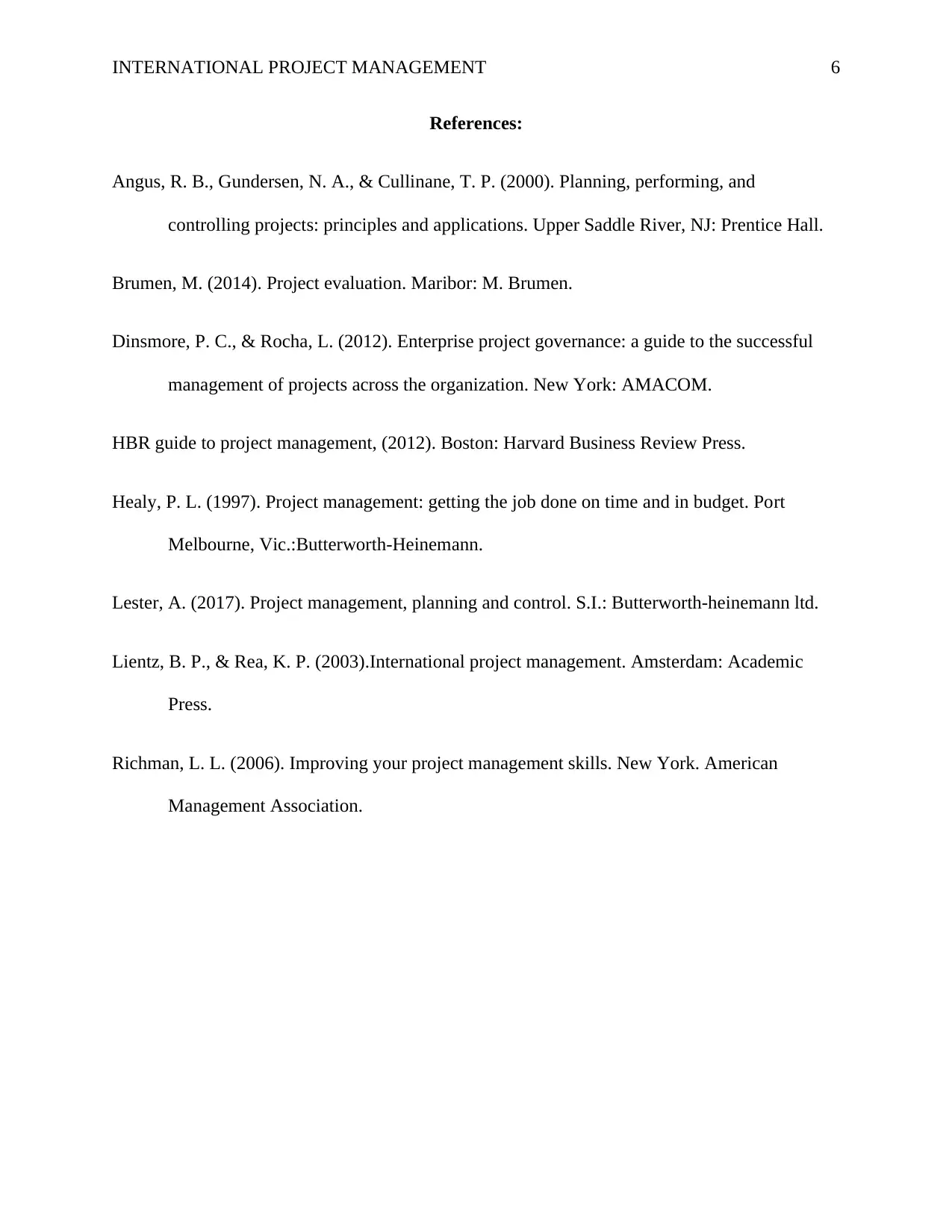
INTERNATIONAL PROJECT MANAGEMENT 6
References:
Angus, R. B., Gundersen, N. A., & Cullinane, T. P. (2000). Planning, performing, and
controlling projects: principles and applications. Upper Saddle River, NJ: Prentice Hall.
Brumen, M. (2014). Project evaluation. Maribor: M. Brumen.
Dinsmore, P. C., & Rocha, L. (2012). Enterprise project governance: a guide to the successful
management of projects across the organization. New York: AMACOM.
HBR guide to project management, (2012). Boston: Harvard Business Review Press.
Healy, P. L. (1997). Project management: getting the job done on time and in budget. Port
Melbourne, Vic.:Butterworth-Heinemann.
Lester, A. (2017). Project management, planning and control. S.I.: Butterworth-heinemann ltd.
Lientz, B. P., & Rea, K. P. (2003).International project management. Amsterdam: Academic
Press.
Richman, L. L. (2006). Improving your project management skills. New York. American
Management Association.
References:
Angus, R. B., Gundersen, N. A., & Cullinane, T. P. (2000). Planning, performing, and
controlling projects: principles and applications. Upper Saddle River, NJ: Prentice Hall.
Brumen, M. (2014). Project evaluation. Maribor: M. Brumen.
Dinsmore, P. C., & Rocha, L. (2012). Enterprise project governance: a guide to the successful
management of projects across the organization. New York: AMACOM.
HBR guide to project management, (2012). Boston: Harvard Business Review Press.
Healy, P. L. (1997). Project management: getting the job done on time and in budget. Port
Melbourne, Vic.:Butterworth-Heinemann.
Lester, A. (2017). Project management, planning and control. S.I.: Butterworth-heinemann ltd.
Lientz, B. P., & Rea, K. P. (2003).International project management. Amsterdam: Academic
Press.
Richman, L. L. (2006). Improving your project management skills. New York. American
Management Association.
⊘ This is a preview!⊘
Do you want full access?
Subscribe today to unlock all pages.

Trusted by 1+ million students worldwide
1 out of 6
Related Documents
Your All-in-One AI-Powered Toolkit for Academic Success.
+13062052269
info@desklib.com
Available 24*7 on WhatsApp / Email
![[object Object]](/_next/static/media/star-bottom.7253800d.svg)
Unlock your academic potential
Copyright © 2020–2025 A2Z Services. All Rights Reserved. Developed and managed by ZUCOL.





